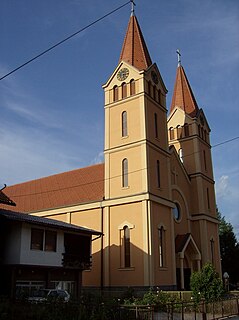
Travnik is a town and a municipality in Bosnia and Herzegovina. It is the administrative center of Central Bosnia Canton of the Federation of Bosnia and Herzegovina. It is situated in central Bosnia and Herzegovina, 90 kilometres west of Sarajevo. As of 2013, the town had a population of 15,344 inhabitants, while the municipality had 53,482 inhabitants.

Žepče is a town and municipality located in Zenica-Doboj Canton of the Federation of Bosnia and Herzegovina, an entity of Bosnia and Herzegovina. It is situated in central Bosnia and Herzegovina, between Doboj and Zenica. As of 2013, it has a population of 30,219 inhabitants.

This article is about the Demographic history of Bosnia and Herzegovina, and deals with the country's documented demographics over time. For an overview of the various ethnic groups and their historical development, see Ethnic groups in Bosnia and Herzegovina.

Ahmići is a village in central Bosnia and Herzegovina. It is located in the municipality of Vitez in the Lašva river valley.
Dario Kordić is a Bosnian Croat former politician from the Croatian Democratic Union, military commander of the Croatian Defence Council (HVO) between 1992 and 1994, vice president of the Croatian Republic of Herzeg-Bosnia, a self-proclaimed Croat territory in Bosnia and Herzegovina and convicted war criminal. He was sentenced to 25 years in prison in February 2001 for war crimes committed against the Bosniak population during the 1992–94 Bosniak-Croat war, and was released in June 2014 after having served two thirds of his sentence.

The Ahmići massacre was the murder of approximately 120 Bosniak civilians by members of the Croatian Defence Council in April 1993, during the Croat–Bosniak War. The massacre was the culmination of the Lašva Valley ethnic cleansing committed by the political and military leadership of the Croatian Community of Herzeg-Bosnia. It was the largest massacre committed during the conflict between Bosnian Croats and the Bosniak-dominated Bosnian government.

The Lašva Valley ethnic cleansing, also known as the Lašva Valley case, refers to numerous war crimes committed during the Bosnian war by the Croatian Community of Herzeg-Bosnia's political and military leadership on Bosnian Muslim (Bosniak) civilians in the Lašva Valley region of Bosnia-Herzegovina. The campaign, planned from May 1992 to March 1993 and erupting the following April, was meant to implement objectives set forth by Croat nationalists in November 1991. The Lašva Valley's Bosniaks were subjected to persecution on political, and religious grounds, deliberately discriminated against in the context of a widespread attack on the region's civilian population and suffered mass murder, rape, imprisonment in camps, as well as the destruction of cultural sites and private property. This was often followed by anti-Bosniak propaganda, particularly in the municipalities of Vitez, Busovača, Novi Travnik and Kiseljak.

The Lašva Valley is a 17 kilometers long valley in central Bosnia, defined geographically by the Lašva River's route. It is a tributary of the Bosna River. The Lašva River basin covers the territory of four municipalities: Travnik, Novi Travnik, Vitez and Busovača.

The Croat–Bosniak War was a conflict between the Republic of Bosnia and Herzegovina and the Croatian Community of Herzeg-Bosnia, supported by Croatia, that lasted from 19 June 1992 – 23 February 1994. The Croat-Bosniak War is often referred to as a "war within a war" because it was part of the larger Bosnian War.
Doljani is a village in the municipality of Konjic, Bosnia and Herzegovina.
Dubravice is a village in the municipality of Konjic, Bosnia and Herzegovina.
Gradeljina is a village in the municipality of Konjic, Bosnia and Herzegovina.
Oteležani is a village in the eastern municipality of Konjic, Bosnia and Herzegovina.
Ovčari is a village in the municipality of Konjic, Bosnia and Herzegovina.
Požetva is a village in the municipality of Konjic, Bosnia and Herzegovina.
Seonica is a village in the municipality of Konjic, Bosnia and Herzegovina.
Spiljani is a village in the municipality of Konjic, Bosnia and Herzegovina.
Vrci is a village in the municipality of Konjic, Bosnia and Herzegovina.
Vrdolje is a village in the municipality of Konjic, Bosnia and Herzegovina.
Veruša is a village in the municipality of Visoko, Bosnia and Herzegovina.







